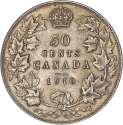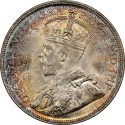You are about to finish your registration. Please check your mailbox (including spam folder). There should be a letter with a confirmation link. Check setting to make sure that your e-mail address is correct.
Send letter againDescription
George V (1865–1936) was King of the United Kingdom and the British Dominions, and Emperor of India, from 6 May 1910 until his death in 1936. He was the only Emperor of India to be present at his own Delhi Durbar. His reign saw the rise of socialism, communism, fascism, Irish republicanism, and the Indian independence movement, all of which radically changed the political landscape. In 1917, George became the first monarch of the House of Windsor, which he renamed from the House of Saxe-Coburg and Gotha as a result of anti-German public sentiment.
Obverse
_Annas_4/1919-1921_18.08.2021_23.04-60.jpg)
|
Crowned and draped bust of the King facing left, surrounded by the inscription, the King is wearing the Imperial Crown and the ermine Robe of State, the Collars of the Star of India and Indian Empire and the Badge of the Most Honourable Order of the Bath. GEORGE V KING EMPEROR |
|---|---|
Reverse
_Annas_4/1919-1921_18.08.2021_23.04_01-60.jpg)
|
Denomination within a square, 4 Annas in Urdu, Bengali, Telugu & Devanagari. 4 |
| Edge |
Characteristics
| Material | Cupronickel |
| Weight | 6.5 g |
| Diameter | 24 mm |
| Thickness | - |
| Shape |
|
| Notches | 8 |
| Alignment | Medal |
| Mints |
Bombay Mint (•) Calcutta Mint (no mintmark)
|
_Annas_4/1919-1921_18.08.2021_23.04.jpg)
_Annas_4/1919-1921_18.08.2021_23.04_01.jpg)
_Annas_4/1919-1921_18.08.2021_23.04_02.jpg)
_Annas_4/1919-1921_18.08.2021_23.04_02-60.jpg)





